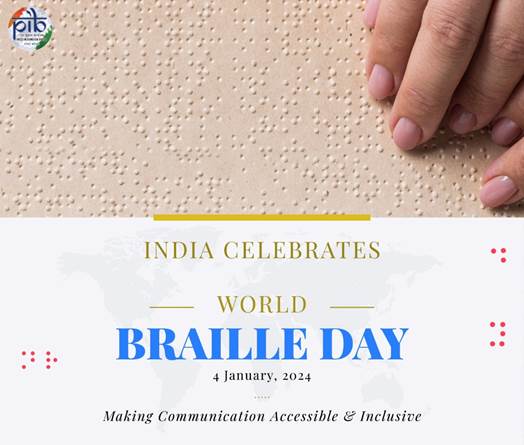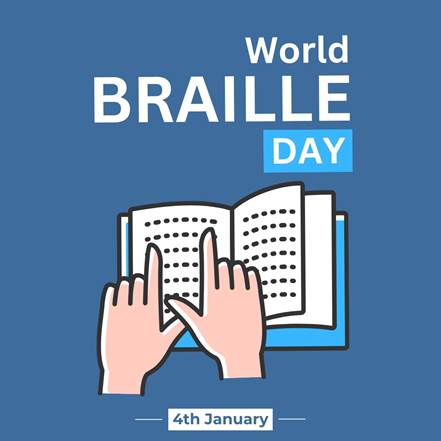Others
World Braille Day (January 04)
Posted On: 04 JAN 2024 3:11PM
Background:
Eye conditions are widely prevalent, with global estimates from the World Health Organization indicating that at least 1 billion individuals suffer from either near or distance vision impairments, conditions that could have been prevented or addressed.
Individuals with vision impairments are disproportionately affected by higher rates of poverty and disadvantage compared to those without such impairments. Failing to address their needs or uphold their rights results in far-reaching consequences, as vision loss often perpetuates a lifetime of inequality, compromised health, and barriers to education and employment.

The Convention on the Rights of Persons with Disabilities, established in 2006, has played a pivotal role in advancing the rights and well-being of individuals with disabilities. The Convention recognizes Braille as essential for education, freedom of expression and opinion, access to information, and social inclusion. Aligning with this, the 2030 Agenda for Sustainable Development, adopted in 2015, commits to leaving no one behind, ensuring that all individuals can lead prosperous and fulfilling lives.
In November 2018, the United Nations General Assembly declared 4 January as World Braille Day. This recognition underscores the importance of inclusive written communication in realising human rights and fundamental freedoms.
Introduction:
As per Census 2011, the number of divyangjan (persons with disabilities) in India is 2,68,14,994, out of which 50,33,431 are persons with visual impairments.
World Braille Day, celebrated since 2019, is observed to raise awareness of the importance of Braille as a means of communication in the full realization of the human rights of blind and partially sighted people. 4th January holds special importance as it marks the birthday of Louis Braille, the visionary inventor of the Braille script, born in France in 1809.
What is Braille?
Braille is a tactile representation of alphabetic and numerical symbols using six dots to represent each letter and number, and even musical, mathematical and scientific symbols. Braille (named after its inventor in 19th century France, Louis Braille) is used by blind and partially sighted people to read the same books and periodicals as those printed in a visual font.

Government of India has undertaken a comprehensive array of initiatives to empower visually impaired individuals, emphasizing their rights, education, employment, and overall well-being. Through legislation such as the Rights of Persons with Disabilities Act 2016, dedicated schemes like the Assistance to Disabled Persons for Purchase/Fitting of Aids and Appliances, and institutions like the National Institute for the Empowerment of Persons with Visual Disabilities, significant strides have been made.
These efforts encompass accessible education, financial support, and inclusive policies, reflecting a commitment to fostering an environment where visually impaired individuals can thrive and contribute to society.
Some of the Important Initiatives for the Empowerment of Visually Impaired Persons
Rights of Persons with Disabilities Act 2016
Under this act, there are various provisions available for welfare and improvement of lives of the persons with disabilities (divyangjans). Under these provisions, various schemes such as Scheme of Assistance to Disabled Persons for Purchase/Fitting of Aids and Appliances (ADIP Scheme), scholarship for education, skill development etc. are implemented.
- Section 34 of the Act provides for 4 per cent reservation in the government employment for all disabilities which includes 1% reservation in Govt. jobs for the visually impaired.
- Section 37 of the said Act provides 5% reservation in allotment of agriculture land and housing as well as in all poverty alleviation and developmental schemes for persons with benchmark disabilities (PwBD) with priority to women with benchmark disabilities.
- Section 32 of the said Act provides for reservation of not less than 5% seats in Govt./Govt. aided higher educational institutions for PwBD.
National Divyangjan Finance and Development Corporation (NDFDC):
The corporation channelizes concessional loans for the socio-economic empowerment of Persons with Disabilities (divyangjans) including visually impaired persons through “Divyangjan Swavlambn Yojna (DSY)” and “Vishesh Microfinance Yojana (VMY)” throughout the country.
Rehabilitation Council of India (RCI)
The council is running 167 institutions across the country for visually impaired students. To know about them, click here.
Sugamya Bharat Abhiyan (Accessible India Campaign):
- Accessible India Campaign has fostered a more inclusive society in the country by addressing the accessibility needs of persons with disabilities.
- Work has been done by the Central Government in three areas i.e. Built-Up Environment, Transportation Sector and the ICT Ecosystem (Websites) to create a universal barrier-free environment.
To know about the details of the outcomes of the Accessible India Campaign (AIC), click here.
National Institute for the Empowerment of Persons with Visual Disabilities (Divyangjan):
- The institute is running a residential Model School for the Visually Handicapped (MSVH) imparting school education to children with visual impairment from preschool to class XII, in which the education is imparted in Braille.
- The institute encourages visually impaired children to get school education. The Institute has established 13 new Braille presses across the country during 2014-2023 as well as modernized 12 existing Braille presses to benefit visually impaired students.
- Since 2014, the Institute has been implementing the "Project on Financial Support for Development of Accessible Learning Materials" under the SIPDA Scheme to provide free-of-cost learning materials in accessible formats (Braille, Large and ePub) to school-going children with visual impairment across the country.
Indian Sign Language Research and Training Centre (ISLRTC)
- ISLRTC has developed and implemented a two-year course Diploma in Teaching Indian Sign Language (DTISL) specifically for students with hearing disabilities. The DTISL course aims to train the students to become teachers of Indian Sign Language.
- The Centre in collaboration with NCERT is working to convert textbooks of classes I-XII into Indian Sign Language to provide educational material to deaf children in an accessible language. Textbooks of classes I-VI have been converted into ISL. The ISL content is available for free on various platforms such as DIKSHA portal and ISLRTC’s YouTube channel.
- ISLRTC has developed an Indian Sign Language Dictionary of 10,500 terms including terms of everyday use and academic terms. The dictionary is available for free on DIKSHA portal, ISLRTC’s YouTube channel, Google Drive and on an app called Sign Learn app.
Scheme of ‘Assistance to Disabled Persons for Purchase/Fitting of Aids/Appliances (ADIP)
Under this scheme, Braille script equipment is provided to children/ persons with visual impairment for their education and rehabilitation across the country as per their needs/requirements.
Deendayal Divyangjan Rehabilitation Scheme (DDRS):
Under this scheme, grant-in-aid is provided to non-governmental organizations (NGOs) for running Special Schools for Disabled Children. The total number of Special Schools for children with visual disability under DDRS is 28. For more details, click here.
Bharati Braille Code
Government has developed and implemented the 'Bharati Braille Code' for Indian languages which are used across the country to educate children with visual impairment. Braille script is being used for all official major languages included in the Eighth Schedule of the Indian Constitution.
Blindness Control Program:
Under the Ministry of Health and Family Welfare, 3 Blindness Control programmes are being implemented, namely:
- National Trachoma Control Program -1963,
- National Program for Control of Blindness- 1976,
- National Program for Control of Blindness & Visual Impairment-2017
Further, a major intervention under the Blindness Control program is the implementation of the Mission Mode Cataract Surgery Campaign (Netra Jyoti Abhiyan) from 2022-25. The national target of cataract surgeries for the FY 2022-23 was 75, 00,000. The achievement for the FY 2022-23 is 83,44,824.
QR Code on Food Products for Visually Impaired Persons
In order to enhance the accessibility of information by Visually impaired individuals, Food Safety and Standards Authority of India (FSSAI) has issued an advisory on 12.10.2023 wherein Food Business Operators (FBOs) are encouraged to incorporate provisions that facilitate easy access to nutritional information for visually impaired individuals. One effective means to achieve this is by incorporating Quick Response (QR) codes on product labels.
Use of QR codes will enhance the accessibility of information and encourage FBOs to adopt an inclusive approach while designing their food labels.
Honouring and Recognising the Visually impaired Persons:
Government of India has been honouring visually impaired persons who have made remarkable achievements, by presenting them with National Awards for Persons with Disabilities. For more details, click here.
Providing Opportunities to Divyangjan
Divya Kala Shakti and 11 Divya Kala Melas have been organized by the Department of Empowerment of Persons with Disabilities to provide opportunities for disabled people to showcase their talent and to promote the sale of the products made by them. For more details, click here.
Skill Development:
National Action Plan (NAP) for Skill Development of Persons with Disabilities (divyangjans) was launched in March, 2015.
- Skill Training: Skill training is conducted for Divyangjans through the portal across the country.
- Divyangjan Rozgar Setu: The platform aims to act as a bridge between PwDs and employers having jobs for PwDs. The platform provides geo-tagged information on employment/earning opportunities within private companies as well as about divyangjans across India.
Click here to Download PDF.
References:
*****
Nimish Rustagi/ Himanshu Pathak/ Ritu Kataria
(Backgrounder ID: 151769)
Visitor Counter : 2250